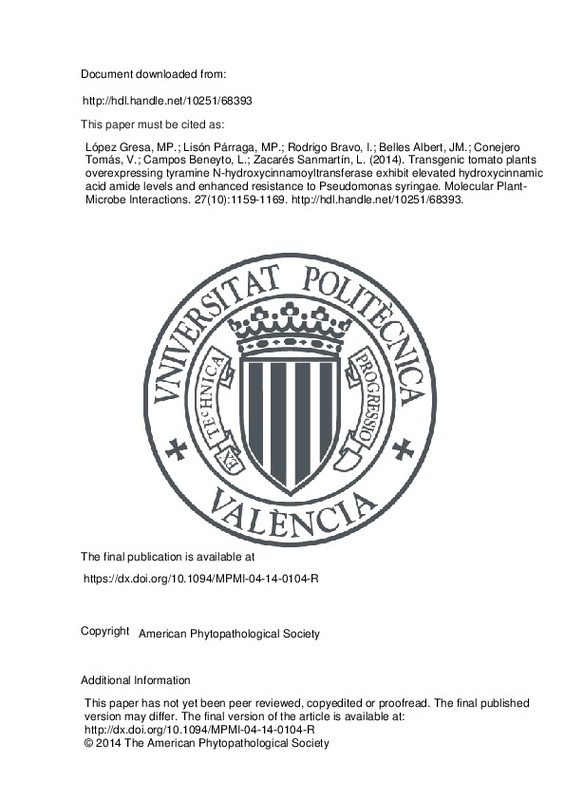JavaScript is disabled for your browser. Some features of this site may not work without it.
Buscar en RiuNet
Listar
Mi cuenta
Estadísticas
Ayuda RiuNet
Admin. UPV
Transgenic tomato plants overexpressing tyramine N-hydroxycinnamoyltransferase exhibit elevated hydroxycinnamic acid amide levels and enhanced resistance to Pseudomonas syringae
Mostrar el registro sencillo del ítem
Ficheros en el ítem
| dc.contributor.author | Campos Beneyto, Laura
|
es_ES |
| dc.contributor.author | Lisón Párraga, María Purificación
|
es_ES |
| dc.contributor.author | López Gresa, Mª Pilar
|
es_ES |
| dc.contributor.author | Rodrigo Bravo, Ismael
|
es_ES |
| dc.contributor.author | Zacarés Sanmartín, Laura
|
es_ES |
| dc.contributor.author | Conejero Tomás, Vicente
|
es_ES |
| dc.contributor.author | Belles Albert, José Mª
|
|
| dc.date.accessioned | 2016-07-28T11:40:53Z | |
| dc.date.available | 2016-07-28T11:40:53Z | |
| dc.date.issued | 2014-10 | |
| dc.identifier.issn | 0894-0282 | |
| dc.identifier.uri | http://hdl.handle.net/10251/68393 | |
| dc.description | This paper has not yet been peer reviewed, copyedited or proofread. The final published version may differ. The final version of the article is available at: http://dx.doi.org/10.1094/MPMI-04-14-0104-R © 2014 The American Phytopathological Society | es_ES |
| dc.description.abstract | [EN] Hydroxycinnamic acid amides (HCAA) are secondary metabolites involved in plant development and defense that have been widely reported throughout the plant kingdom. These phenolics show antioxidant, antiviral, antibacterial, and antifungal activities. Hydroxycinnamoyl-CoA: tyramine N-hydroxycinnamoyl transferase (THT) is the key enzyme in HCAA synthesis and is induced in response to pathogen infection, wounding, or elicitor treatments, preceding HCAA accumulation. We have engineered transgenic tomato plants overexpressing tomato THT. These plants displayed an enhanced THT gene expression in leaves as compared with wild type (WT) plants. Consequently, leaves of THT-over-expressing plants showed a higher constitutive accumulation of the amide coumaroyltyramine (CT). Similar results were found in flowers and fruits. Moreover, feruloyltyramine (FT) also accumulated in these tissues, being present at higher levels in transgenic plants. Accumulation of CT, FT and octopamine, and noradrenaline HCAA in response to Pseudomonas syringae pv. tomato infection was higher in transgenic plants than in the WT plants. Transgenic plants showed an enhanced resistance to the bacterial infection. In addition, this HCAA accumulation was accompanied by an increase in salicylic acid levels and pathogenesis-related gene induction. Taken together, these results suggest that HCAA may play an important role in the defense of tomato plants against P. syringae infection. | es_ES |
| dc.description.sponsorship | The authors are grateful to C. Torres, A. Sauri, and T. Caballero for technical support. We also thank C. Gomez-Mena for her assistance in tomato flower sampling. This work was supported by Grant BIO2012-33419 from the Direccion General de Programas y Transferencia de Conocimiento, from the Spanish Ministry of Science and Innovation. L. Campos was the recipient of a predoctoral fellowship ACIF/2010/231 from Generalitat Valenciana (Spain). The work presented here was carried out in collaboration between all authors. J. M. Belles defined the research theme. L. Campos, L. Zacares and M. P. Lopez-Gresa carried out the laboratory experiments. P. Lison and I. Rodrigo contributed to the experimental design and the interpretation of the data. L. Campos drafted the article. M. P. Lopez-Gresa, P. Lison and I. Rodrigo participated in revising it critically for important intellectual content. J. M. Belles and V. Conejero gave the final approval of the version to be published. Each author has participated sufficiently in the work to take public responsibility for the content. | en_EN |
| dc.language | Inglés | es_ES |
| dc.publisher | American Phytopathological Society | es_ES |
| dc.relation.ispartof | Molecular Plant-Microbe Interactions | es_ES |
| dc.rights | Reserva de todos los derechos | es_ES |
| dc.subject | CELL-SUSPENSION-CULTURES | es_ES |
| dc.subject | CARTHAMUS-TINCTORIUS L. | es_ES |
| dc.subject | SOLANUM-TUBEROSUM | es_ES |
| dc.subject | SALICYLIC-ACID | es_ES |
| dc.subject | HYPERSENSITIVE RESPONSE | es_ES |
| dc.subject | GENTISIC ACID | es_ES |
| dc.subject | XANTHOMONAS-CAMPESTRIS | es_ES |
| dc.subject | DISEASE RESISTANCE | es_ES |
| dc.subject | NICOTIANA-TABACUM | es_ES |
| dc.subject | TOBACCO-LEAVES | es_ES |
| dc.subject.classification | BIOQUIMICA Y BIOLOGIA MOLECULAR | es_ES |
| dc.title | Transgenic tomato plants overexpressing tyramine N-hydroxycinnamoyltransferase exhibit elevated hydroxycinnamic acid amide levels and enhanced resistance to Pseudomonas syringae | es_ES |
| dc.type | Artículo | es_ES |
| dc.identifier.doi | 10.1094/MPMI-04-14-0104-R | |
| dc.relation.projectID | info:eu-repo/grantAgreement/MINECO//BIO2012-33419/ES/CARACTERIZACIÓN DE GENES Y METABOLITOS IMPLICADOS EN LA RESPUESTA DEFENSIVA DE LAS PLANTAS FRENTE A PATÓGENOS/ | es_ES |
| dc.relation.projectID | info:eu-repo/grantAgreement/GVA//ACIF%2F2010%2F231/ | es_ES |
| dc.rights.accessRights | Abierto | es_ES |
| dc.contributor.affiliation | Universitat Politècnica de València. Departamento de Biotecnología - Departament de Biotecnologia | es_ES |
| dc.description.bibliographicCitation | Campos Beneyto, L.; Lisón Párraga, MP.; López Gresa, MP.; Rodrigo Bravo, I.; Zacarés Sanmartín, L.; Conejero Tomás, V.; Belles Albert, JM. (2014). Transgenic tomato plants overexpressing tyramine N-hydroxycinnamoyltransferase exhibit elevated hydroxycinnamic acid amide levels and enhanced resistance to Pseudomonas syringae. Molecular Plant-Microbe Interactions. 27(10):1159-1169. https://doi.org/10.1094/MPMI-04-14-0104-R | es_ES |
| dc.description.accrualMethod | S | es_ES |
| dc.relation.publisherversion | https://dx.doi.org/10.1094/MPMI-04-14-0104-R | es_ES |
| dc.description.upvformatpinicio | 1159 | es_ES |
| dc.description.upvformatpfin | 1169 | es_ES |
| dc.type.version | info:eu-repo/semantics/publishedVersion | es_ES |
| dc.description.volume | 27 | es_ES |
| dc.description.issue | 10 | es_ES |
| dc.relation.senia | 272036 | es_ES |
| dc.identifier.eissn | 1943-7706 | |
| dc.contributor.funder | Generalitat Valenciana | es_ES |
| dc.contributor.funder | Ministerio de Economía y Competitividad | es_ES |
| dc.contributor.funder | Ministerio de Ciencia e Innovación | es_ES |







![[Cerrado]](/themes/UPV/images/candado.png)

